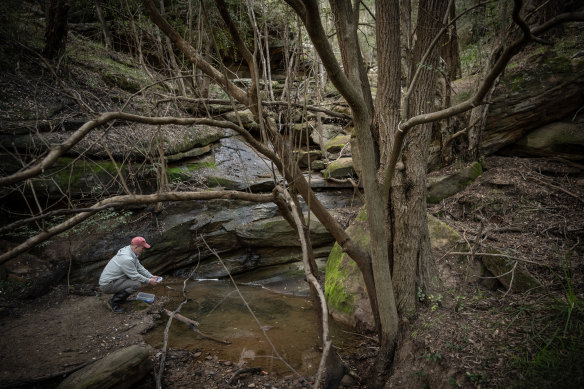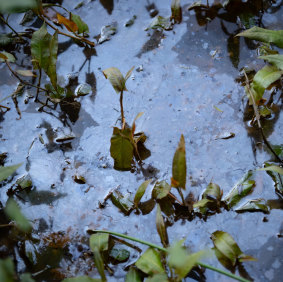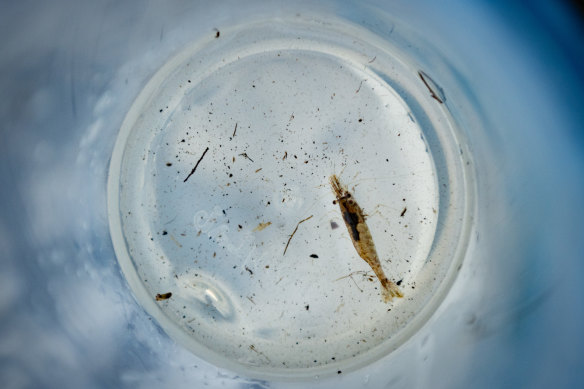“The difference in water quality upstream [compared] to the contamination zone is stark,” said Wright, an experienced water pollution investigator who carried out independent tests on samples from the wetlands.
Building waste and rubble seen at the edge of the Wheeny Creek wetlands.Credit: Wolter Peeters
“In my view, this was a major pollution incident of unknown proportions. It has probably caused considerable ecological damage to what should be a healthy creek and important wetland habitat.”
A formal survey has yet to be done on the wetland, but the preliminary tests conducted this month showed many contaminants near the dump site present at levels well above “trigger values” – the thresholds which, according to EPA guidelines, mean a site should be subject to further investigation or immediate action.
Aluminium levels upstream were undetectable but in the pollution plume were 20 times the safe level for aquatic life, especially the microscopic creatures that form the basis of the food chain.
Copper was present in the polluted water at five times the “trigger value” level, zinc at four times the limit, lead at three times the limit, and the salinity of the water was far higher in the pollution plume than upstream.
Loading
“I have formed an opinion that this would have harmed or killed many sensitive species,” Wright said.
The EPA issued Hughes with clean-up notices after it became aware of dumping at the site in 2020, but has sent mixed messages about the water pollution.
In a clean-up notice sent to Hughes in August 2022, the agency said its officers had observed material spilling down a steep slope towards the wetlands, and “the EPA reasonably suspects that a water pollution incident has occurred or is occurring”.
But in an email to an external party in August 2023, seen by the Herald, the agency said it thought water pollution was negligible.
The EPA did not directly respond to questions about why it had not acted to prevent toxic material from leaking into the wetland, saying it could not comment on water pollution because it formed part of the court proceedings.

Dr Ian Wright taking water samples at the edge of the wetlands.Credit: Wolter Peeters
“We take all ongoing reports of water pollution seriously and will conduct further testing of water and soils surrounding the creek,” a spokesperson said.
“In NSW, the ‘polluter pays’ principle applies, and we will seek to hold those responsible to account.”
Hughes’ lawyer, Zali Burrows, said in a statement: “Mr Hughes is and has always been eager to help the EPA to protect our natural environment, but he strongly denies the allegations that have been made against him and intends to vigorously defend himself.”

An oily sheen is visible on the water within the pollution plume.Credit: Wolter Peeters
Hughes is defending six charges including failure to comply with a clean-up notice.
The Wheeny Creek site was the subject of a major investigation by the EPA involving secret cameras, drones and covert surveillance by officers.
But documents seen by the Herald show there was conflict within the organisation over the management of the case, with a senior investigator raising serious allegations of mismanagement.
The investigator emailed management saying it was “apparent that these investigations [have] not been managed properly”, and the Wheeny Creek operation had “lost its way”.
Covert surveillance cameras were removed while still gathering evidence, the investigator told management. They also raised concerns about cost-cutting causing problems for pollution tests and EPA lawyers allegedly failing to communicate with police lawyers who were also involved in the case.

A freshwater prawn caught upstream from the pollution plume. None were located within the contaminated area.Credit: Wolter Peeters
“This site is the largest by volume land pollution investigation that the NSW EPA has investigated,” the investigator wrote. “We need to divert all resources to have this investigation progressed or we risk the reality that we will not proceed with a tier 1 land pollution charge.”
Rather than tier 1 charges – the strongest sanctions the agency can apply, relating to large-scale deliberate pollution – the agency is largely proceeding with lesser tier 2 charges in the case that is now before the court.
Wright said the pollution incident appeared to be ongoing, with pollutants continuing to enter the wetlands and move downstream towards the Colo River.
He said he was “puzzled” that even simple remedial measures such as placing sediment filters or a barrier of secured hay bales to prevent contaminated waste entering the waterway had not been deployed.
“I find this bizarre,” he said.
Get to the heart of what’s happening with climate change and the environment. Sign up for our fortnightly Environment newsletter.

